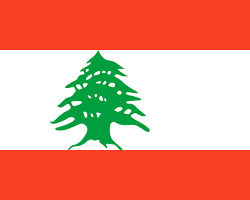Lebanon or the Lebanese Republic is located in the western part of the Asian continent, within the Middle East region, specifically in the region overlooking the eastern part of the Mediterranean coast, at the point where three of the world’s continents meet. They are Europe, Asia, and Africa. From an astronomical standpoint, Lebanon occupies a position on longitude (35'50) and latitude (33'50).
Lebanon has land borders extending over a distance of 484 km, and coastal borders, as it shares its land borders with the Syrian Arab Republic on the northern and eastern sides, with a border length of 403 km. It is bordered by the State of Palestine on the southern side, with a border distance of up to 81 km, while its western borders overlook On the Mediterranean coast.
Lebanon is distinguished by the many archaeological and natural tourist attractions that exist and extend over its territory, in addition to the tourist culture it contains that extends throughout history. Many European orientalists, such as Alphonse de Lamartine, Ernest Renan and Victor Green, contributed to shedding light on the Lebanese culture in the Levant through their visits to this country. Tourism in Lebanon constitutes one of the state's most important financial revenues, and it also depends heavily on Lebanese expatriates who return to spend their vacations within the country during the summer. Lebanese antiquities are diverse in a way that reflects the history of the ancient and modern world. It contains many Roman temples, Phoenician cities, Crusader castles, Ottoman baths, Mamluk mosques, and ancient churches, in addition to the natural landmarks it contains, such as the beautiful beaches located on the Mediterranean Sea, in addition to caves made of limestone. Lebanese cuisine is considered one of the most famous international cuisines. It is also one of the most Arab countries in which winter sports such as skiing can be practiced, through many mountain ski resorts. Lebanon is also famous for its prosperous and active life during the night periods. To learn more about the most important things that Lebanon is famous for, and that may interest tourists during their visit to it, you can see the article What is Lebanon famous for?
The Lebanese Republic has a subtropical climate in general. Dry and hot weather appears during the summer, and tends to be humid and moderate during the winter months, while the Mediterranean climate prevails in the coastal areas. It is characterized by mild and rainy winters, and dry, humid, and hot summers. Lebanon is characterized by hot magmatic winds that blow in its direction from the north of the African continent in the spring, and sometimes during the fall. As for the areas located in the northern part of the country, they are affected by the cold winds coming from the European continent. This is in the winter. In short, the southern regions are characterized by warmer climates, while the northern coastal regions are characterized by being more humid and cooler. Heading towards the mountains of Lebanon, the weather becomes colder, and is suitable for larger amounts of rain to fall as the altitude increases, which means a colder winter, in addition to the prevalence of snow, especially on the mountain peaks that are covered by this snow most of the year, while summer is characterized by a decline at night. During the day, the temperature is similar to that of the coastal areas, and the height of the mountains helps reduce the influence of the Mediterranean climate, which leads to greater daily differences in temperatures. Due to the influence of the Lebanon Mountains on the Bekaa Valley, it witnesses less humidity and rainfall than what is found in the coastal areas, and despite the fact that snowfall there is greater than that which falls on the Lebanon Mountains, it witnesses a wide range of temperatures, on a daily basis. And annually. As for the eastern Lebanon mountain range, it is characterized by lower temperatures than in the Bekaa Valley, and it also enjoys high levels of rainfall.

